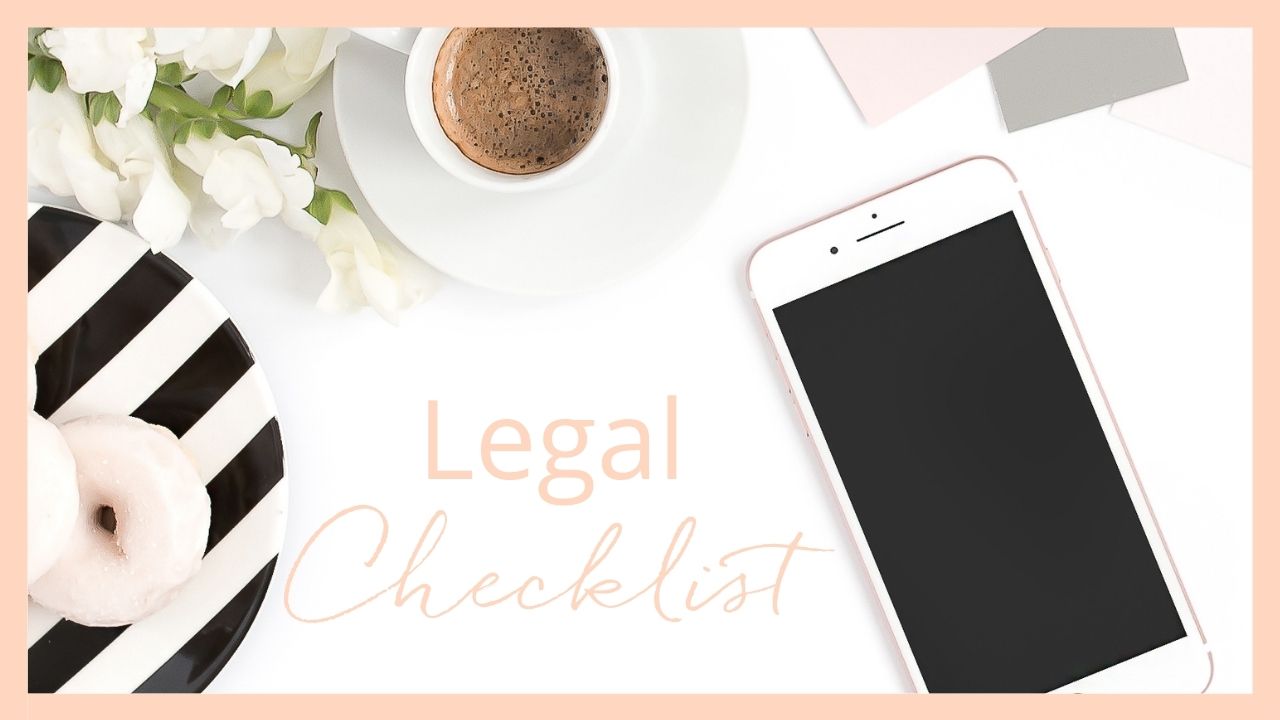
If you’ve made the decision to start a business online, or are already running one online, chances are the first thing you will do is create a website to start generating content, sell your products, and start getting your name out there. While I can’t help you with the technical side of how to actually create a website, I CAN help you make sure that website is legally compliant with United States federal laws…which is also pretty important, since you are now a business owner!
In order to make it as easy as possible, I’ve put together the top three steps you need to take in order to keep your website legally compliant, and protect yourself and your business, to give you piece of mind as you’re building your following:
- Privacy Policy
When we think of starting an online business, what comes to mind is typically creating a website, and then using that website to start collecting names and email addresses to build your list or following, right? Yes! However, there is a VERY important step here that you cannot afford to miss. Within the United States, according to federal laws, if you have a live website that allows you to collect personal information from users (think name, email addresses, payment information etc.) you are required to include a Privacy Policy at the bottom of your website. This privacy policy should include information such as what you are collecting, what steps you take to make sure the information you collect is secure, what you plan to do with the information, and how someone can go about correcting or deleting the information from your database (aka unsubscribing from your list.) If you do nothing else to protect your business legally in the beginning, THIS is the one step to take, to avoid noncompliance with the FTC.
- Disclaimer
Once you take the time to make sure your website is compliant with US federal privacy laws, the next step is to think about protecting yourself and your business from liability. If you are a coach or online business owners, your website is likely filled with beautiful content including your story, why you do what you do, client testimonials and success stories, and detailed information about packages and programs you offer to clients. When this information is posted to your website, you assume people will read it, and make a decision for themselves as to whether or not they’d like to work with you, and you assume people will use common sense and evaluate their own personal situation in deciding whether they can and want to work with you.
However, we can’t always control who visits our websites, and what those people think, or where they are in their personal lives. We’d like to think everyone will use common sense and not act against their best interests – but – that’s just not the world we live in today. The last thing you want is for someone to misunderstand or misinterpret the information on your website, take your advice, and suffer some kind of harm from it – like lose their job or home, become ill, or take your advice over their own doctor or accountant. SO! In order to prevent YOU from being liable, should someone like this stumble upon your website, we include a Disclaimer on your site, nestled perfectly next to your privacy policy ?. Your disclaimer is where you will want it clearly stated that everything on your website is for information purposes only, and is not meant to take the place of a consultation with a doctor, lawyer, accountant, etc. who can assess their personal situation. Additionally, you may want to include information clarifying that you cannot guarantee outcomes of specific people, and that a client testimonial may not reflect “typical” results, or other similar language to CYA. Essentially, the Disclaimer is the key piece of paper that protects you and your business from those who may misunderstand or misinterpret information from your website.
- Terms and Conditions
Once you’ve made your website compliant, and shielded your business from liability, the last document needed on your website are your Terms and Conditions! This document is typically longer than the Privacy Policy and Disclaimer, and includes all the ground rules for what people can and cannot do on your website – essentially, it’s the closest you will get to a signed contract from everyone who visits your website, agreeing to your terms of use to use your website. Some important information to include:
- Content – your Terms and Conditions are where you will advise website visitors that you own the content on your website (aka your “intellectual property”) and that they may not copy or reuse without your permission. This is SO valuable should someone else copy your content!
- Payment/Programs – you can also include general information here about how you take payment, your refund policy, etc. to inform users how it works if they want to buy something from your website
- Jurisdiction and Dispute Resolution – if you find yourself in the unfortunate situation where someone feels they have been harmed by your or your website and wants to file a claim against you, THIS paragraph will save your booty. This is where you will outline that any disputes related to your website or business are to be resolved IN THE STATE YOU LIVE IN! (Hooray for no last-minute trips out of the country to defend yourself in a lawsuit!) You can also specify that disputes are to be resolved out of court, in a specific county, etc. which further protects you, should anything go south.
In sum, when starting an online business, your website NEEDS: (1) a Privacy Policy to keep you compliant with federal laws, (2) a Disclaimer to protect you and your business from those who may misunderstand or misuse information from your website, and (3) Terms and Conditions, to set the ground rules for your website, including content protection, dispute resolution, and all the other fun details associated with your website. ?
If you’re feeling motivated to finally cross these things off your “to-do” list, head over to my Legal Info page HERE, and set yourself up with my website bundle!
Xoxo
Christy
Grab my FREE Legal Checklist to see if Your Business is Legally Compliant!


This is fantastic information very clearly laid out. Thank you.